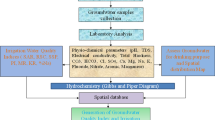Abstract
The scarcity of water is one of the main issues in Saudi Arabia. In particular, the extreme climate in the form of less frequent rainfall affects the groundwater availability. Moreover, groundwater has been depleted by the increase in population. In this research, the spatial distribution of groundwater quality has been developed, and the prediction of groundwater chemical parameters has been made using geostatistical analysis in geographic information system (GIS) software. The study area is Madrakah village as the recharge area of Wadi Usfan located in the western region of Saudi Arabia. Ordinary kriging method was applied to map the spatial distribution of the groundwater chemistry. Most of the groundwater is not suitable for drinking purposes. Groundwater chemical parameters are decreasing toward the eastern part of Madrakah village. In predicting groundwater chemistry distribution maps, data transformation has been executed to reduce the skewness on most of the chemical parameters. The best semivariogram model for every parameter varies based on the root mean square error (RMSE) criterion. The groundwater chemical parameters, i.e., Na+, Mg2+, Cl−, conductivity, salinity, and total dissolved solid (TDS), have a strong spatial dependence, while, NO3 − and temperature have a moderate and weak spatial dependence, respectively.










Similar content being viewed by others
References
Ahmadi SH, Sedghamiz A (2007) Geostatistical analysis of spatial and temporal variations of groundwater level. Environ Monit Assess 129:277–294. doi:10.1007/s10661-006-9361-z
Alyamani MS, Hussein MT (1995) Hydrochemical study of groundwater in recharge area, Wadi Fatimah Basin, Saudi Arabia. GeoJurnal 37(1):81–89. doi:10.1007/BF00814887
Ayazi MH, Pirasteh S, Arvin AKP, Pradhan B, Nikouravan B, Mansor S (2010) Disasters and risk reduction in groundwater: Zagros Mountain Southwest Iran using geoinformatics techniques. Disaster Adv 3(1):51–57
David M (1977) Geostatistical ore reserve estimation. Elsevier, Amsterdam
Davis ML, Cornwell DA (1991) Introduction to environmental engineering. McGraw-Hill, New York
De Marsily G (1984) Spatial variability of properties in porous media: a stochastic approach. In: Bear J, Corapcioglu M (eds) Fundamentals of transport phenomena in porous media. Martinus Nijho, Dordrecht, pp 721–769
Drewes JE, Khan SJ (2011) Water quality and treatment: a handbook on drinking water. In: Edzwald JK (ed) Water reuse for drinking water augmentation, 6th edn. McGraw-Hill, New York, pp 16.1–16.48
Effendi H (2003) Telaah kualitas air, bagi pengelolaan sumber daya dan lingkungan perairan (English: Study of water quality, for water resource and environmental management), 7th edn. Penerbit Kanisius, Yogyakarta, Indonesia
El Afly M (2012) Integrated geostatistics and GIS techniques for assessing groundwater contamination in Al Arish area, Sinai, Egypt. Arab J Geosci 5(2):197–215. doi:10.1007/s12517-010-0153-y
El-Hames AS (2005) Determination of groundwater availability in shallow arid region aquifers utilizing GIS technology: a case study in Hada Al-Sham, western Saudi Arabia. Hydrogeol J 13(4):640–648. doi:10.1007/s10040-004-0323-7
Johnston K, Hoef JMV, Krivoruchko K, Lucas N (2001) ArcGIS® 9: using ArcGIS® geostatistical analyst. ESRI. http://dusk.geo.orst.edu/gis/geostat_analyst.pdf. Accessed 8 Oct 2012
Kotb H, Saidi SM, Hakim H (1988) Hydrochemical characteristics of groundwater in the Usfan Basin, Saudi Arabia. JKAU Earth Sci I:113–132
Kumar V, Remadevi (2006) Kriging of groundwater levels—a case study. J Spat Hydrol 6(1):81–92
Machiwal D, Mishra A, Jha MK, Sharma A, Sisodia SS (2012) Modeling short-term spatial and temporal variability of groundwater level using geostatistics and GIS. Arab J Geosci 21(1):117–136. doi:10.1007/s11053-011-9167-8
Manap MA, Nampak H, Pradhan B, Lee S, Sulaiman WNA, Ramli MF (2012) Application of probabilistic-based frequency ratio model in groundwater potential mapping using remote sensing data and GIS. Arab J Geosci. doi:10.1007/s12517-012-0795-z
Manap MA, Sulaiman WNA, Ramli MF, Pradhan B, Surip N (2013) A knowledge driven GIS modelling technique for prediction of groundwater potential zones at the Upper Langat Basin, Malaysia. Arab J Geosci 6(5):1621–1637
McNeely RN, Nelamnis VP, Dwyer L (1979) Water quality source book: a guide to water quality parameter. Inland Waters Directorates, Water Quality Branch, Ottawa
Mehrjardi RT, Jahromi MZ, Mahmodi S, Heidari A (2008) Spatial distribution of groundwater quality with geostatistics (case study: Yazd-Ardakan Plain). World Appl Sci J 4(1):9–17
Nayanaka VGD, Vitharana WAU, Mapa RB (2010) Geostatistical analysis of soil properties to support spatial sampling in a paddy growing alfisol. Trop Agric Res 22(1):34–44. doi:10.4038/tar.v22i1.2668
Neshat A, Pradhan B, Pirasteh S, Shafri HZM (2013) Estimating groundwater vulnerability to pollution using modified DRASTIC model in the Kerman agricultural area. Iran Environ Earth Sci. doi:10.1007/s12665-013-2690-7
Olea RA (1999) Geostatistics for engineers and earth scientists. Kluwer Academic, Boston
Post GB, Atherholt TB, Cohn PD (2011) Water quality and treatment: a handbook on drinking water. In: Edzwald JK (ed) Health and aesthetic aspects of drinking water, 6th edn. McGraw-Hill, New York, pp 2.1–2.100
Pradhan B (2009) Ground water potential zonation for basaltic watersheds using satellite remote sensing data and GIS techniques. Cent Eur J Geosci 1(1):120–129. doi:10.2478/v10085-009-0008-5
Shamsudduha M (2007) Spatial variability and prediction modeling of groundwater arsenic distributions in the shallowest alluvial aquifers in Bangladesh. J Spat Hydrol 7(2):33–46
Subyani AM (2010) Identifying the hydrochemical processes of groundwater in Wadi Na'man, western Saudi Arabia using factor analysis. Arab J Geosci 5(3):501–511. doi:10.1007/s12517-010-0207-1
WHO (2008) Guidelines for drinking-water quality (electronic resource): incorporating 1st and 2nd Addenda, vol. 1, recommendations, 3rd edn. ESRI, Geneva. http://www.who.int/water_sanitation_health/dwq/gdwq3rev/en/. Accessed 8 Oct 2012
Acknowledgments
The authors would like to thank the Saudi Arabia Geological Survey for providing the data to perform such analysis. The third author is on leave of absence from the Faculty of Engineering, Mansoura University, Egypt. The authors thank Dr. Tariq Cheema, from the Waterloo University, Canada (currently at King Abdulaziz University, Jeddah, Kingdom of Saudi Arabia) for proofreading the manuscript.
Author information
Authors and Affiliations
Corresponding author
Rights and permissions
About this article
Cite this article
Marko, K., Al-Amri, N.S. & Elfeki, A.M.M. Geostatistical analysis using GIS for mapping groundwater quality: case study in the recharge area of Wadi Usfan, western Saudi Arabia. Arab J Geosci 7, 5239–5252 (2014). https://doi.org/10.1007/s12517-013-1156-2
Received:
Accepted:
Published:
Issue Date:
DOI: https://doi.org/10.1007/s12517-013-1156-2




